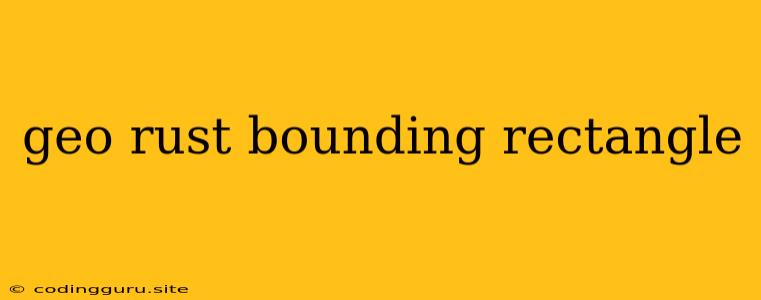Understanding Geo-Rust and Bounding Rectangles
Geo-Rust is a powerful library in Rust that allows you to work with geographic data effectively. One crucial aspect of working with geographic data is understanding how to represent and manipulate spatial objects. Bounding rectangles play a vital role in this process, providing a simplified representation of complex geometries.
What is a Bounding Rectangle?
A bounding rectangle, also known as a Minimum Bounding Rectangle (MBR), is the smallest rectangle that completely encloses a given geographic shape or set of points. Imagine you have a complex polygon representing a lake. Its bounding rectangle would be the smallest rectangle that encompasses the entire lake's area.
Why Use Bounding Rectangles?
Bounding rectangles offer numerous advantages in geographic data processing:
- Spatial Indexing: They are fundamental for building spatial indexes, which allow for efficient searching and retrieval of data based on location.
- Collision Detection: Bounding rectangles are used for quickly detecting collisions between objects, such as determining if two polygons intersect.
- Spatial Queries: When performing spatial queries, like finding all points within a certain distance of a given location, bounding rectangles can help filter out irrelevant objects.
- Simplified Representation: They provide a simplified representation of complex geometries, making it easier to handle and perform calculations.
Geo-Rust and Bounding Rectangles
Geo-Rust offers a convenient way to work with bounding rectangles. The library provides various functions for creating, manipulating, and using bounding rectangles in your applications.
How to Create a Bounding Rectangle in Geo-Rust
use geo::{BoundingRect, Point};
// Create a point
let point = Point::new(1.0, 2.0);
// Create a bounding rectangle from the point
let rect = BoundingRect::from_point(&point);
// Print the bounding rectangle
println!("{:?}", rect);
This code snippet demonstrates how to create a bounding rectangle from a point. The BoundingRect::from_point() method is used to generate the rectangle that encompasses the point.
Beyond Points: Calculating Bounding Rectangles for Complex Shapes
Geo-Rust allows you to calculate bounding rectangles for various types of geographic objects, including polygons, lines, and collections of points. For polygons, you can use the BoundingRect::from_polygon() method, while for lines, you can use the BoundingRect::from_linestring() method.
Example: Calculating the Bounding Rectangle of a Polygon
use geo::{BoundingRect, Polygon};
// Create a polygon
let polygon = Polygon::new(
vec![
Point::new(1.0, 1.0),
Point::new(2.0, 1.0),
Point::new(2.0, 2.0),
Point::new(1.0, 2.0),
Point::new(1.0, 1.0),
],
vec![], // Interior rings are not used in this example
);
// Calculate the bounding rectangle
let rect = BoundingRect::from_polygon(&polygon);
// Print the bounding rectangle
println!("{:?}", rect);
Using Bounding Rectangles for Spatial Queries
Let's illustrate how to use bounding rectangles for spatial queries in Geo-Rust. Consider a scenario where you want to find all points within a certain distance of a given location.
use geo::{BoundingRect, Point};
// Define the target location
let target_point = Point::new(1.0, 1.0);
// Define the search radius
let radius = 1.0;
// Create a bounding rectangle around the target point with the search radius
let search_rect = BoundingRect::from_point_radius(&target_point, radius);
// Loop through points and check if they fall within the bounding rectangle
for point in points {
if search_rect.contains_point(&point) {
// Process the point (it falls within the search radius)
}
}
This code snippet demonstrates using bounding rectangles to efficiently filter points within a specific search radius.
Conclusion
Bounding rectangles are a crucial component of working with geographic data. Geo-Rust provides a powerful and convenient way to create, manipulate, and leverage bounding rectangles for tasks like spatial indexing, collision detection, and spatial queries. Understanding the power of bounding rectangles is essential for efficient and accurate geographic data processing in Rust.
